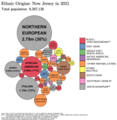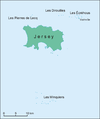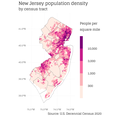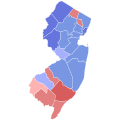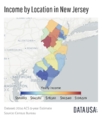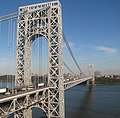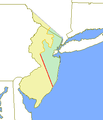Portal:New Jersey
The New Jersey Portal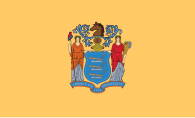 New Jersey is a state located in both the Mid-Atlantic and Northeastern regions of the United States, at the geographic hub of the heavily urbanized Northeast megalopolis. New Jersey is bordered to the northwest, north, and northeast by New York State; on its east, southeast, and south by the Atlantic Ocean; on its west by the Delaware River and Pennsylvania; and on its southwest by Delaware Bay and Delaware. At 7,354 square miles (19,050 km2), New Jersey is the fifth-smallest state in land area, but with over 9.5 million residents as of 2024 U.S. Census Bureau estimates, its highest population ever, the state ranks 11th in population. The state capital is Trenton, and the state's most populous city is Newark. New Jersey is the only U.S. state in which every county is deemed urban by the U.S. Census Bureau, and is the most densely populated U.S. state. New Jersey was first inhabited by Paleo-Indians as early as 13,000 B.C.E. The Lenape were the dominant Indigenous group when Europeans arrived in the early 17th century, and they were subdivived into dialectal groups such as the Munsee, in the north, and the Unami and the Unalachtigo, elsewhere. Dutch and Swedish colonists founded the first European settlements in the state, with the British later seizing control of the region and establishing the Province of New Jersey, named after Jersey. The colony's fertile lands and relative religious tolerance drew a large and diverse population. New Jersey was among the Thirteen Colonies that supported the American Revolution, hosting several pivotal battles and military commands in the American Revolutionary War. New Jersey remained in the Union during the American Civil War and provided troops, resources, and military leaders in support of the Union Army. After the war, the state emerged as a major manufacturing center and a leading destination for immigrants, helping drive the Industrial Revolution in the U.S. New Jersey was the site of many industrial, technological, and commercial innovations. Many prominent Americans associated with New Jersey have proven influential nationally and globally, including in academia, advocacy, business, entertainment, government, military, non-profit leadership, and other fields. (Full article...) Selected article -
Rogers Locomotive and Machine Works was a 19th-century manufacturer of railroad steam locomotives based in Paterson, in Passaic County, New Jersey, in the United States. It built more than six thousand steam locomotives for railroads around the world. Most railroads in 19th-century United States rostered at least one Rogers-built locomotive. The company's most famous product was a locomotive named The General, built in December 1855, which was one of the principals of the Great Locomotive Chase of the American Civil War. Rogers was the second-most popular American locomotive manufacturer of the 19th century behind the Baldwin Locomotive Works amongst almost a hundred manufacturers.
The company was founded by Thomas Rogers in an 1832 partnership with Morris Ketchum and Jasper Grosvenor as Rogers, Ketchum and Grosvenor. Rogers remained president until his death in 1856 when his son, Jacob S. Rogers, took the position and reorganized the company as Rogers Locomotive and Machine Works. The younger Rogers led the company until he retired in 1893. Robert S. Hughes then became president and reorganized the company as Rogers Locomotive Company, which he led until his death in 1900. Rogers avoided the American Locomotive Company (ALCO) merger in 1901 through closing and reopening as Rogers Locomotive Works. The company remained independent until 1905, when ALCO purchased it; ALCO continued building new steam locomotives at the Rogers plant until 1913. ALCO used the Rogers facilities through the 1920s as a parts storage facility and warehouse, but eventually sold the property to private investors. Today, several Rogers-built locomotives exist in railroad museums around the world, and the plant's erecting shop is preserved as the Thomas Rogers Building; it is the current location of the Paterson Museum, whose mission is to preserve and display Paterson's industrial history. Selected picture -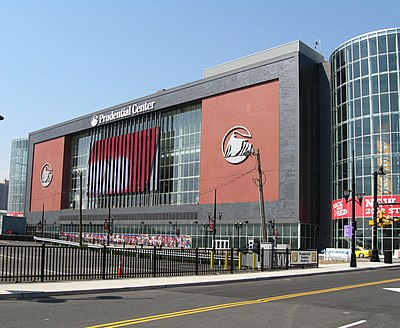 Credit: Jim.henderson The Prudential Center (nicknamed "The Rock") is a multi-purpose indoor arena in Downtown Newark. The arena was designed by HOK Sport, with the exterior designed by Morris Adjmi Architects. It is the home of the New Jersey Devils. New Jersey news'Related portalsSelected biography -Garret Augustus Hobart (June 3, 1844 – November 21, 1899) was the 24th vice president of the United States, serving from 1897 until his death in 1899, under President William McKinley. A member of the Republican Party, Hobart was an influential New Jersey businessman, politician, and political operative prior to his vice presidency. Hobart was born in Long Branch, New Jersey, on the Jersey Shore, and grew up in nearby Marlboro. He attended Rutgers College in New Brunswick, and read law under Paterson-based attorney Socrates Tuttle. He both studied with Tuttle and married his daughter, Jennie. Although he rarely set foot in a courtroom, Hobart became wealthy as a corporate lawyer. Hobart served in local governmental positions, and then successfully ran for office as a Republican, serving in both the New Jersey General Assembly, where he was elected Speaker in 1874, and the New Jersey Senate, where he became its president in 1881. (Full article...) Did you know? -
General imagesThe following are images from various New Jersey-related articles on Wikipedia.
TopicsQuality content
CategoriesThings you can do
For more information on how you can help, see the WikiProject New Jersey. Associated WikimediaThe following Wikimedia Foundation sister projects provide more on this subject:
Discover Wikipedia using portals |







